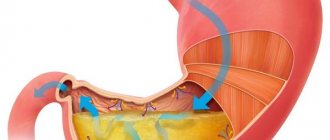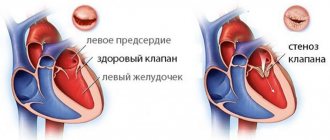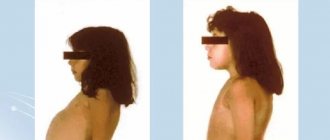Causes of heartburn in the throat
Burning and discomfort in the throat can occur in completely healthy people. The most common cause of such symptoms is errors in diet: abuse of spicy or salty foods, caffeine-containing drinks, which cause an increase in the production of hydrochloric acid, causing it to be thrown into the throat. Heartburn can also be caused by smoking and frequent alcohol consumption. A burning sensation is often observed in pregnant women, especially in the second and third trimesters, which is associated with an increase in intra-abdominal pressure and a reflex opening of the cardiac sphincter.
Laryngopharyngeal reflux (LPR)
The backflow of aggressive stomach contents into the cavity of the pharynx and larynx is the main cause of heartburn in the throat. The mechanism of the disease is associated with uncoordinated work of the upper and lower sphincters of the esophagus with constant relaxation of the sphincters of the hypopharynx. As a result of regurgitation (backflow) of liquid contents with a pH below 4, the mucous membrane of the throat is irritated. An important role in the progression of laryngopharyngeal reflux is played by disruption of the reflex reactions of the larynx to an irritant.
The clinical picture of LPR is characterized by a combination of heartburn and nonspecific respiratory complaints: episodic dry cough, mucous discharge from the oropharynx, increased production of saliva. Sometimes the sensation is described by patients as a squeezing “lump in the throat.” An important sign of the disorder is the aggravation of unpleasant symptoms in a horizontal position, due to the entry of more gastric juice into the upper respiratory tract.
Disorders of the acid-producing function of the stomach
The appearance of heartburn can be caused by increased production of hydrochloric acid by the lining cells of the body of the stomach, which provokes the opening of the cardiac sphincter and the reflux of chyme (liquid, partially digested food) into the pharynx. Often the symptom is combined with burning and soreness behind the sternum. A discomfort in the throat also develops due to decreased acid production and stagnation of chyme. In this case, the unpleasant sensations are potentiated by organic acids, which are produced in large quantities during the decomposition of food in the stomach. Typically a burning sensation in the throat is caused by:
- Gastritis
. At the initial stages of mucosal inflammation caused by exposure to bacterial flora, the production of hydrochloric acid increases significantly. A decrease in the pH of gastric juice in combination with uncoordinated contractions of the sphincters leads to the reflux of contents into the overlying sections of the gastrointestinal tract with a feeling of heartburn in the throat. The disease is also manifested by sour belching, constipation and epigastric pain. - Peptic ulcer disease
. The formation of an ulcerative defect in the mucosa, caused by an increase in aggressive factors and a decrease in protective factors, always occurs with pronounced dyspeptic disorders. With a gastric ulcer, heartburn is caused by impaired motility and gaping of the cardiac sphincter. With duodenal ulcers, duodenal-gastric reflux is observed, against the background of which the mucous membrane of the throat is irritated by duodenal contents. - Gastrinoma
. A gastrin-producing tumor located in the pancreas or antrum of the stomach provokes an uncontrolled increase in the secretion of hydrochloric acid, which does not depend on food intake. In this case, sour belching, heartburn in the throat and burning behind the sternum, severe pain in the epigastric region are determined. The condition is aggravated by the addition of steatorrhea, which develops when food is malabsorbed. - Pyloric stenosis
. The transition between the stomach and duodenum is often narrowed due to cicatricial processes in the pylorus, which is accompanied by inhibition of hydrochloric acid production and causes prolonged stagnation of partially digested food masses. As a result, macromolecules decompose with the formation of organic acids. Stretching the gastric wall triggers reverse peristalsis and promotes acid reflux into the pharynx. - Atrophic gastritis
. The disease is of an autoimmune nature or occurs in the late stages of bacterial gastritis, when the lining cells of the mucous membrane are completely destroyed. Heartburn is associated with increased formation of lactic and pyruvic acids due to decomposition and putrefaction of undigested food. The burning sensation is combined with rotten belching, vomiting of eaten food, alternating constipation and diarrhea.
Other diseases of the digestive system
The feeling of heartburn in the throat often indicates diseases of the underlying parts of the digestive system. Burning and pain in the laryngopharynx are sometimes detected with irritation and erosion of the mucous membrane due to the ingress of small intestinal contents with a large amount of bile acids. Secondary disorders of the motor function of the smooth muscles of the gastrointestinal tract and incoordination of the gastric sphincters aggravate the symptoms. The main causes of heartburn are:
- Duodenitis
. Dyspeptic disorders, along with pain, are the main signs of inflammation of the duodenum. A burning sensation in the throat occurs due to the irritating effect of hydrochloric acid and bile acids on the mucous membrane of the pharynx. Unpleasant sensations are combined with nausea and vomiting, a tendency to unstable stools, and bitter belching. The cholecyst-like form of the disorder occurs as biliary colic. - Enzyme deficiency
. Heartburn with a decrease in exocrine pancreatic function is a sign of exacerbation of chronic pancreatitis and gastrointestinal motility disorders caused by duodenogastric reflux. Characteristic signs are steatorrhea and lientorrhea - the discharge of loose, grayish stool with undigested food debris. Malabsorption leads to rapid weight loss. - Perisplenitis
. Heartburn due to inflammation of the spleen capsule usually has a neuro-reflex nature and is caused by impaired gastric motility. The symptom is accompanied by burning pain in the left hypochondrium, which radiates to the scapula, left arm and cardiac region. A typical combination of pain with an increase in body temperature and signs of general intoxication of the body. Unpleasant manifestations intensify with physical activity, coughing, sneezing. - Adductor loop syndrome
. Frequent episodes of stagnation of digested food in the blind part of the intestine in diseases of the operated stomach lead to distension of the intestine and its throwing back into the stomach. The smooth muscles of the gastric wall reflexively contract, then aggressive chyme enters the esophagus and pharynx. In addition to burning sensations in the throat, vomiting after eating, a feeling of heaviness and fullness in the epigastrium, and weight loss are possible.
Neurological diseases
Dyspeptic disorders in pathologies of the central nervous system are often provoked by dysregulation of the autonomic innervation of the abdominal organs. Symptoms such as heartburn, nausea, and abdominal pain are usually signs of visceral paroxysms. Unpleasant sensations from the gastrointestinal tract are often combined with other types of autonomic reactions: pallor, increased sweating, rapid heartbeat. A burning sensation in the throat area is caused by:
- Temporal lobe epilepsy
. Heartburn and other dyspeptic disorders arise due to the involvement in the pathological process of the autonomic centers responsible for the innervation of internal organs. These symptoms manifest themselves both as individual somatosensory paroxysms and as an “aura” before a typical epileptic attack. Over time, epilepsy leads to emotional and intellectual impairment. - Alcoholic encephalopathy
. Burning sensation, discomfort in the throat, nausea and vomiting, and bowel movements are warning signs of the disease. They are associated with the local and general toxic effects of ethanol and its metabolites. The full clinical picture of the disease is characterized by visual and auditory hallucinations, alternating periods of chaotic excitation and depression of the central nervous system. In severe cases, brain dysfunction develops into psychoorganic syndrome and dementia.
Itsenko-Cushing's disease
Heartburn with overproduction of adrenal hormones is formed due to increased production of gastrin and hydrochloric acid in the stomach. A decrease in the acidity of gastric juice and impaired motility of the upper parts of the digestive tract cause the flow of acidic contents into the laryngopharynx. In addition to dyspepsia, in Itsenko-Cushing's disease, pathognomonic signs of the pathology are determined: Cushingoid appearance (significant fat deposits in the torso area, moon-shaped face), purple stretch marks (skin stretch marks) on the thighs and abdomen, cardiovascular pathology.
Viral infections
The combination of dyspeptic disorders with respiratory symptoms is characteristic of measles in young children. Periodic reflux of gastric chyme is associated with functional disorders of gastrointestinal motility due to general intoxication and the specific action of the pathogen. Heartburn in the throat is a secondary nonspecific symptom that occurs against the background of the main manifestations: lacrimation, serous rhinitis, dry cough. The destruction of the epithelial layer under the influence of viral particles aggravates the burning sensation in the laryngopharynx.
Laryngopharyngeal reflux in gastroenterological practice
Gastroesophageal reflux disease (GERD) is one of the most common pathologies of the gastrointestinal tract. At the International Congress of Gastroenterology, held in Montreal in 2005, a unified definition of the disease, a description of symptoms and a classification of the disease were developed, which formed the basis of the Montreal Consensus [1]. The Consensus divides the clinical manifestations of GERD into esophageal and extraesophageal syndromes. The presence of reflux-associated symptoms in the absence of damage to the esophageal mucosa is regarded as esophageal syndrome, manifested solely by symptoms, and in the presence of damage to the esophageal mucosa - as esophageal syndromes with damage to the esophagus (complications). Extraesophageal syndromes were divided, in turn, into syndromes whose connection with GERD has been established, and syndromes whose connection with GERD is suspected. Extraesophageal syndromes with an established connection with GERD include reflux cough, reflux laryngitis, reflux asthma and reflux-induced destruction of tooth enamel, and syndromes with a presumptive connection with GERD include pharyngitis, sinusitis, pulmonary idiopathic fibrosis and recurrent otitis media [ 2, 3].
The word “reflux” itself literally means “reverse flow”. GERD is detected in many patients with chronic laryngitis. Otorhinolaryngologists often refer to this condition as laryngopharyngeal reflux (LPR), which represents the retrograde entry of stomach contents - acid and pepsin, as well as bile acids into the laryngopharynx [4, 5]. There are a number of synonyms for LPR, such as extraesophageal reflux, reflux laryngitis and laryngeal reflux. There is currently no gold standard for diagnosing LPR, and therefore data on its epidemiology are limited. In one study of 105 normal healthy volunteers, 86% had laryngopharyngeal reflux during laryngoscopy [6]. In a meta-analysis by AL Merati et al. analyzed data from pH probe readings in 264 patients with LPR; as a result, gastroesophageal reflux was detected in 10–60% of patients [7]. Studies such as these show that LPR is common in the general population, but needs to be diagnosed in some patients before adequate treatment can be given.
Normally, the upper esophageal sphincter and, to some extent, the larynx protect the lower respiratory tract from the entry of contents from the esophagus and stomach. The larynx is very well innervated and any esophageal reflux in a normal person will cause a protective cough. In patients with LPR, this “safety mechanism” may fail. For example, JE Aviv et al. The study showed that sensory deficits may play a role in the formation of LPR. The authors found a decrease in the laryngeal reflex in response to endoscopic air insufflation in patients with documented LPR [8]. Most researchers propose two main pathophysiological mechanisms for LPR, which directly or indirectly cause damage to the larynx by the contents of the esophagus and stomach. The direct mechanism is the result of the action of gastric contents (acid, pepsin and/or bile acids) acting directly on the mucous membrane of the hypopharynx. The indirect mechanism manifests itself as a result of the effect of reflux on the reflex structures of the larynx. This irritation is thought to cause bronchospasm, which in turn stimulates the vagal response, usually resulting in a nonproductive cough. The delicate ciliated epithelium of the posterior wall of the larynx, which normally evacuates mucus from the trachea, is significantly damaged by contact with gastroduodenal chemical agents, which can lead to mucous stasis in the larynx and discomfort [9]. Recently, it has been suggested that the enzyme carbonic anhydrase, which stimulates bicarbonate secretion, protects laryngeal tissues from reflux and that this protective mechanism may be impaired in the larynx of patients with LPR [10].
Most patients diagnosed with LPR may not have the classic symptoms of GERD. The main symptoms of LPR are respiratory complaints such as pain or burning in the throat, chronic cough (51%), excessive expectoration of mucus (42%), dysphonia (71%), dysphagia (35%), lump in the throat (47%), vertical (daytime) reflux, laryngospasm [11]. Researchers estimate that up to 50% of patients with laryngeal and voice disorders have reflux [12]. Based on laryngoscopy data, a special scale of “reflux signs” (SRS) was developed in 2001, which included 8 characteristic laryngoscopic symptoms with a general assessment of their severity from 0 to 26 points, which are presented in table. 1 [13]. Conducted by MF Vaezi et al. studies have shown that the presence of more than 7 points on the SRS correlated by 95% with positive data from 24-hour esophageal pH monitoring and suggested the presence of LPR [14]. Many patients with LPR often turn to a phoniatrist because they do not have pathognomonic complaints. If a patient’s dysphonia continues for more than three months, he or she should be screened to detect LPR [15].
Unfortunately, the specificity of laryngoscopic findings and their assessment using the presented SRS is not very high [6]. In 2002, the authors who developed the SRS also proposed the “Reflux Symptoms Index” (RSI) questionnaire, recommended for assessing the effectiveness of LPR treatment with proton pump inhibitors (PPIs), which consists of 9 questions and includes a dynamic assessment of a number of indicators (Table 2). Each IRS symptom is rated over the past month on a scale from 0 (no problems) to 5 (severe problems). A score of more than 13 correlates with a positive result of pH monitoring [13]. It is a self-administered tool that helps clinicians assess the clinical severity of LPR symptoms at diagnosis and then over time after treatment. The IRS is significantly higher in patients with LPR than in healthy controls (21.2 vs. 11.6, p < 0.001). However, this indicator is rarely used by general practitioners and otolaryngologists [16]. In 2004, R. Williams et al. proposed a scale for assessing the severity of chronic laryngitis in otorhinolaryngological manifestations of the extraesophageal form of GERD: degree 0 - no signs of inflammation, degree I (mild) hyperemia and/or swelling in the area of the arytenoid cartilages and interarytenoid space, degree II (moderate) - distribution of hyperemia and/ or edema beyond the area of the arytenoid cartilages and the interarytenoid space to the vocal folds, degree III (severe) - the presence of ulcerations in the area of the arytenoid cartilages and the interarytenoid space or the spread of the inflammatory process to the subvocal part of the larynx [17].
As is known, the most sensitive test for practical diagnosis of pathological acid gastroesophageal reflux is daily intraesophageal pH monitoring, when intraesophageal pH is continuously recorded at a distance of 5 cm above the lower esophageal sphincter. As a standard test for diagnosing LPR, ambulatory 24-hour intraesophageal hypopharyngeal pH monitoring using two pH sensors is proposed, with the second (proximal) pH sensor for fixing supraesophageal reflux as a cause of ENT disorders installed 5 cm above the upper alimentary sphincter (VPS) [18]. Unfortunately, although hypopharyngeal pH monitoring is a more sensitive test for identifying patients with GERD-induced ENT disorders, negative results cannot exclude LPR due to the intermittent nature of the disease and variability. Currently, a more accurate and patient-friendly method for diagnosing LPR has been developed by measuring naso- and oropharyngeal pH using a special Restech's Dx-pH measurement system, which allows recording pH fluctuations in the oral cavity and nasopharynx every 1/2 s for 48 hours [14 , 19].
Treatment of patients with LPR should include diet, lifestyle modifications, physical therapies, and pharmacotherapy. Modification of diet and lifestyle involves the patient following the following recommendations:
- after eating, you should avoid bending forward, you should go to bed with your head elevated;
- do not wear tight clothes and tight belts;
- avoid large meals;
- do not eat at night;
- limit the consumption of foods that cause a decrease in the pressure of the lower alimentary sphincter (LES) and have an irritating effect (fats, alcohol, coffee, chocolate, citrus fruits);
- stop smoking;
- normalize body weight.
Foods and drinks containing caffeine, alcohol, chocolate and mint relax the lower esophageal sphincter and increase stomach acid production, while carbonated drinks with/or without caffeine increase reflux and belching. In addition, the intake of acidic foods (with a pH below 4.6), such as citrus fruits and other sour fruits, tomatoes, dry wines and some others, should be limited. Lifestyle modifications that can reduce symptoms of LPR, as well as other manifestations of extraesophageal reflux, include smoking cessation and weight loss. A study by DL Steward et al. [20] showed that lifestyle changes for 2 months or more, with or without PPI therapy, significantly reduced the symptoms of chronic laryngitis.
Drug therapy usually includes PPIs, H2 receptor agonists, prokinetics, and cryoprotectants for the laryngeal mucosa. Empirical therapy with PPIs is justified because it can help in the diagnosis ex juvantibus (from the Latin ex - based on, juvanus - helping), i.e. treatment carried out in order to clarify the diagnosis. To date, studies of the effectiveness of PPIs in the treatment of LPR patients have produced a wide range of responses [21].
Studies evaluating the effectiveness of PPIs in LPR show results ranging from very good, with response rates reaching 70%, to no difference with placebo [22]. A controlled trial using lansoprazole 30 mg twice daily for three months in 22 patients with idiopathic chronic laryngitis found that 50% of patients in the treatment group had a complete response compared with 10% in the control group [23]. However, another study using lansoprazole at a similar dosage and regimen found no difference in response rates in patients with laryngopharyngitis [24]. A large multicenter study involving 145 patients with suspected LPR showed no benefit of esomeprazole 40 mg twice daily for four months compared with placebo [25]. One recent study of 85 patients with LPR found that PPI twice daily was more effective than once daily and that extending the course of treatment from two to four months resulted in more positive responses [26]. In general, for LPR, the use of a standard dose of PPI twice daily for two to three months is justified. Current recommendations do not suggest the use of H2-blockers in combination with PPIs in patients with suspected LPR [27, 28]. To achieve the best results, PPIs should be taken on an empty stomach 30 minutes before meals, with a course of treatment of 2–6 months until complete histological remission of laryngitis is achieved [29]. Patients whose quality of life and symptoms do not improve after two to three months of therapy most likely do not have GERD as a cause of LPR, but they should be evaluated for the presence of mixed reflux using manometry and pH monitoring [30]. If there is no effect from taking a PPI, a reassessment of symptoms with the participation of specialists from a pulmonologist and an allergist is necessary [31, 32].
The necessary comprehensive diagnosis and treatment of LPR was demonstrated by E. F. Kokorina, who assessed, in addition to endoscopic signs of esophagitis, the severity of chronic laryngitis in otorhinolaryngological manifestations of the extraesophageal form of GERD using the Williams scale, the level of dysphonia was assessed using the Consensus Auditory-Perceptual Evaluation of Voice (CAPE) scoring scale. V), proposed by the American Speech-Language Hearing Association, 2003. All patients underwent correction of GERD using PPI drugs; for the treatment of LPR in the main group of patients, the drug Erespal was added according to the standard regimen for 3 weeks. The duration of standard antireflux therapy was 3 months. Dynamic assessment of LPR was carried out several times up to 6 months after treatment; a statistically significant acceleration in the regression of reflux-induced changes in the larynx in patients of the main group was revealed [33]. I. L. Klyaritskaya, A. P. Balabantseva in their study showed that the use of double doses of PPI (pantoprazole) for 12 weeks leads to a significant reduction in symptoms of LPR compared to the control group. The optimal duration of treatment is 6–12 months, and after stopping the medication after 6 weeks it leads to an increase in scores on the Reflux Symptom Index questionnaire [34].
It is necessary to consider the use of prokinetics in the complex treatment of both GERD and LPR, which is a manifestation of GERD. Drugs such as metoclopramide, domperidone, cisapride and tegaserod have been used in patients with GERD in the past, but regular use of these drugs is not recommended by current standards due to limited indications and a high side effect profile [35]. In the treatment of GERD today, according to indications, the prokinetic agents itopride and mosapride are used; unfortunately, the latter is not registered in Russia. Itopride, registered in Russia since 2007, is used in patients with LPR as an adjuvant together with PPIs, as well as for other extraesophageal syndromes, accelerating the rate of reduction of symptoms [36, 37]. E. P. Oleinik et al. recommend the use of itopride, based on their own experience of using it in almost 1000 patients, in the complex treatment of all types of voice disorders due to GERD and LPR [38]. F.V. Semenov et al. A study involving 200 patients with LPR assessed the effectiveness of a two-week course of itopride in the treatment of otolaryngological manifestations of LPR. Its use led to a decrease in subjective complaints of patients and a weakening of the severity of laryngoscopic signs such as hyperemia and swelling of the mucous membrane of the arytenoid cartilages [39].
There are several scientific publications in the literature regarding rehabilitation speech therapy treatment of LPR with special voice exercises that strengthen the muscles of the larynx, and in some centers such therapy is carried out empirically without medical evidence-based support. A report on laryngeal rehabilitation in the treatment of chronic cough associated with GERD was recently published with significant improvement in symptoms [40].
The role of surgical fundoplication in patients refractory to even high (double) doses of PPI remains controversial. In a study by J. Swoger et al. evaluated symptoms in 10 PPI-resistant patients after fundoplication compared with 12 PPI-resistant patients who continued conservative treatment with double doses of PPI, showing that only 1 patient (10%) benefited from fundoplication, which was no different from the group comparison (7%) [41]. However, the role of surgery in PPI-resistant patients who have abnormal non-acid reflux remains important. They can be successfully treated with laparoscopic Nissen fundoplication [42]. Today, the Society of American Gastrointestinal and Endoscopic Surgeons clinical guidelines recommend antireflux surgery for patients who: have failed or are intolerant to medications; have significant extraesophageal manifestations such as aspiration, asthma, or cough; have ulcerative strictures as a complication of GERD [43].
Thus, there are no specific lesions of the larynx with laryngopharyngeal reflux, so the diagnosis of this pathology should be comprehensive and include both ENT and gastroenterological examination methods. Treatment of laryngopharyngeal reflux should also be comprehensive, from lifestyle modification and the use of local remedies to a long course of proton pump inhibitors and prokinetics in adequate dosage, and if they are ineffective, surgical treatment methods should be used.
Literature
- Vakil, N. van Zanden S.V., Kahrilas P. et al. The Montreal definition and classification of gastroesophageal reflux disease: A global evidence-based consensus // Am. J. Gastroenterol. 2006. Vol. 101. P. 1900–1920.
- Katz PO, Gerson LB, Vela MF Diagnosis and Management of Gastroesophageal Reflux Disease // Am J Gastroenterol. 2013. Vol. 108. R. 308–328.
- Lazebnik L. B., Bordin D. S., Masharova A. A. Modern understanding of gastroesophageal reflux disease: from Genval to Montreal // Experimental and clinical gastroenterology. 2007. No. 5. P. 4–10.
- Koufman JA, Aviv JE, Casiano RR, Shaw GY Laryngopharyngeal reflux: position statement of the committee on speech, voice, and swallowing disorders of the American Academy of OtolaryngologyHead and Neck Surgery // Otolaryngol Head Neck Surg. 2002. Vol. 127. R. 32–35.
- Ford CN Evaluation and management of laryngopharyngeal reflux // JAMA. 2005. Vol. 294. R. 1534–1540.
- Hicks DM, Ours TM, Abelson TI et al. The prevalence of hypopharynx findings associated with gastroesophageal reflux in normal volunteers // J Voice. 2002. Vol. 16. R. 564–579.
- Merati AL, Lim HJ, Ulualp SO, Toohill RJ Meta-analysis of upper probe measurements in normal subjects and patients with laryngopharyngeal reflux // Ann Otol Rhinol Laryngol. 2005. Vol. 114. R. 177–182.
- Aviv JE, Liu H, Parides M et al. Laryngopharyngeal sensory deficits in patients with laryngopharyngeal reflux and dysphagia // Ann Otol Rhinol Laryngol. 2000. Vol. 109. R. 1000–1006.
- Hanson DG, Jiang JJ Diagnosis and management of chronic laryngitis associated with reflux // Am J Med. 2000. Vol. 108. R. 112S–119S.
- Johnston N., Bulmer D., Gill GA et al. Cell biology of laryngeal epithelial defenses in health and disease: further studies // Ann Otol Rhinol Laryngol. 2003. Vol. 112. R. 481–491.
- Koufman JA The otolaryngologic manifestations of gastroesophageal reflux disease (GERD): a clinical investigation of 225 patients using ambulatory 24-hour pH monitoring and an experimental investigation of the role of acid and pepsin in the development of laryngeal injury // Laryngoscope. 1991. Vol. 101. R. 1–78.
- Koufman JA, Amin MR, Panetti M. Prevalence of reflux in 113 consecutive patients with laryngeal and voice disorders // Otolaryngol Head Neck Surg. 2000. Vol. 123. R. 385–388.
- Belafsky PC, Postma GN, Koufman JA The validity and reliability of the reflux finding score (RFS) // Laryngoscope. 2001. Vol. 111. P. 1313–1317.
- Vaezi MF Sensitivity and specificity of reflux-attributed laryngeal lesions: experimental and clinical evidence // Am. J. Med. 2003. Vol. 115, (Suppl. 3 A). P. 97 S-104.
- Karkos PD, Yates PD, Carding PN, Wilson JA Is laryngopharyngeal reflux related to functional dysphonia? // Ann Otol Rhinol Laryngol. 2007. Vol. 116, No. 1. P. 24–29.
- Ahmed TF, Khandwala F, Abelson TI et al. Chronic laryngitis associated with gastroesophageal reflux: prospective assessment of differences in practice patterns between gastroenterologists and ENT physicians // Am J Gastroenterol. 2006. Vol. 101. R. 470–478.
- Williams RB, Szczesniak MM, Maklean HM et al. Predictors of Outcome in an Open Label, Therapeutic Trial of High-Dose Omeprazol in Laryngitis // Am J Gastroenterol. 2004. Vol. 42. R. 776–785.
- Vincent DA Jr., Garrett JD, Radionoff SL et al. The proximal probe in oesophageal pH monitoring: development of a normative database // J. Voice. 2000. Vol. 14. P. 247–254.
- Ayazi S., Lipham J., Hagen G. et al. A new technique for measurement of pharyngeal pH: normal values and discriminating pH threshold // J. Gastroenterol. Surg. 2009. Vol. 13 (8). P. 1422–1429.
- Steward DL, Wilson KM, Kelly DH et al. Proton pump inhibitor therapy for chronic laryngopharyngitis: a randomized placebo-control trial // Otolaryngol Head Neck Surg. 2004. Vol. 131. R. 342–350.
- Martinucci I., de Bortoli N., Savarino E. et al. Optimal treatment of laryngopharyngeal reflux disease // Ther Adv Chronic Dis. 2013. Nov. Vol. 4 (6). R. 287–301.
- Vaezi MF Extraesophageal manifestations of gastroesophageal reflux disease // Clin Cornerstone. 2003. Vol. 5. R. 32–38.
- El-Serag HB, Lee P, Buchner A et al. Lansoprazole treatment of patients with chronic idiopathic laryngitis: a placebo-controlled trial // Am J Gastroenterol. 2006. Vol. 96. R. 979–983.
- Havas T. et al. Posterior pharyngolaryngitis: double blind randomized placebo controlled trial of proton pump inhibitor therapy // Aust J Otolaryngol. 1999. Vol. 3. R. 243–246.
- Vaezi MF, Richter JE, Stasney CR et al. Treatment of chronic posterior laryngitis with esomeprazole // Laryngoscope. 2006. Vol. 116. R. 254–260.
- Park W., Hicks DM, Khandwala F. et al. Laryngopharyngeal reflux: prospective cohort study evaluating optimal dose of proton-pump inhibitor therapy and pretherapy predictors of response // Laryngoscope. 2005. Vol. 115. R. 1230–1238.
- Peghini PL, Katz PO, Castell DO Ranitidine controls nocturnal gastric acid breakthrough on omeprazole: a controlled study in normal subjects // Gastroenterology. 1998. Vol. 115. R. 1335–1339.
- Fackler WK, Ours TM, Vaezi MF, Richter JE Long-term effect of H2 RA therapy on nocturnal gastric acid breakthrough // Gastroenterology. 2002. Vol. 122. R. 625–632.
- Belafsky PC, Postma GN, Koufman JA Validity and reliability of the reflux symptom index (RSI) // J Voice. 2002. Vol. 16. R. 274–277.
- Yuksel ES, Vaezi MF Extraesophageal manifestations of gastroesophageal reflux disease: cough, asthma, laryngitis, chest pain // Swiss Med Wkly. 2012. Vol. 142. R. l35–44.
- Kahrilas P., Shaheen N., Vaezi M. et al. American Gastroenterological Association Medical Position Statement on the management of gastroesophageal reflux disease // Gastroenterology. 2008. Vol. 135(4). R. 1383–1391, e1381–e1385.
- Zerbib F., Stoll D. Management of laryngopharyngeal reflux: an unmet medical need // Neurogastroenterol Moti. 2010. Vol. l22. R. 109–112.
- Kokorina V. E. Use of the drug erespal in schemes for the correction of reflux-induced laryngitis // Bulletin of Otorhinolaryngology. 2010. No. 6. pp. 61–63.
- Klyaritskaya I. L., Balabantseva A. P. Comparative effectiveness of high daily doses of proton pump inhibitors for laryngopharyngeal reflux // Ukrainian Therapeutic Journal. 2012. No. 1. pp. 21–27.
- Updated guidelines for the diagnosis and treatment of gastroesophageal reflux disease // American Journal of Gastroenterology. 2005. Vol. 100 (1). R. 190–200.
- Ezzat WF, Fawaz SA, Fathey H., El Demerdash A. Virtue of adding prokinetics to proton pump inhibitors in the treatment of laryngopharyngeal reflux disease: prospective study // Journal of Otolaryngology. 2011. Vol. 40 (4). 350–356.
- Chun BJ, Lee DS The effect of itopride combined with lansoprazole in patients with laryngopharyngeal reflux disease // European Archives of Oto-Rhino-Laryngology. 2013. Vol. 270(4). 1385–1390.
- Oleynik E. P., Kochesokova E. A., Ivanchenko G. F., Demchenko E. V. Treatment of patients with dysphonia with gastroesophageal reflux disease // Treating Physician. 2010. No. 9. pp. 7–10.
- Semenov F.V., Gorbonosov I.V., Vartanyan M.S. Experience with the use of itopride for the treatment of otorhinolaryngological manifestations of laryngopharyngeal reflux // Farmateka. 2011. No. 2. pp. 91–95.
- Pacheco A., Cobeta I., Wagner C. Refractory chronic cough: new perspectives in diagnosis and treatment // Arch Bronconeumo. 2013. Vol. l49. R. 151–157.
- Swoger J., Ponsky J., Hicks DM et al. Surgical fundoplication in laryngopharyngeal reflux unresponsive to aggressive acid suppression: a controlled study // Clin Gastroenterol Hepatol. 2006. Vol. 4. R. 433–441.
- Mainie I., Tutuian R., Agrawal A. et al. Combined multichannel intraluminal impedance-pH monitoring to select patients with persistent gastro-oesophageal reflux for laparoscopic Nissen fundoplication // Br J Surg. 2006. Vol. 93. R. 1483–1487.
- Zerbib F., Sifrim D., Tutuian R. et al. Modern medical and surgical management of difficult-to-treat GORD // United Eur Gastroenterol J. 2013. Vol. 1. R. 21–31.
E. Yu. Plotnikova*, 1, Doctor of Medical Sciences, Professor M. V. Krasnova**, Candidate of Medical Sciences K. A. Krasnov**, Candidate of Medical Sciences E. N. Baranova*
* State Budgetary Educational Institution of Higher Professional Education Kemerovo State Medical Academy of the Ministry of Health of the Russian Federation, Kemerovo ** Municipal Budgetary Healthcare Institution City Clinical Hospital No. 3 named after. M. A. Podgorbunsky, Kemerovo
1 Contact information
Abstract. Ethiopathogenetic mechanisms, clinical indicators and diagnostic methods of laryngopharyngital reflux. Modern treatment methods are described that presumably diet, changing of the mode of life, physical treatment methods and drug therapy as well as indications for surgery.
Survey
A gastroenterologist examines patients with discomfort and a burning sensation in the throat. The diagnostic search is primarily aimed at a comprehensive study of the morphological and functional state of the esophagus, stomach, and upper intestines. The diagnostic plan necessarily includes an examination of the respiratory tract to assess the degree of pathological changes. The most valuable for identifying the root causes of heartburn are:
- Endoscopic examination
. Endoscopy allows you to visualize the mucous membrane and detect signs of inflammatory or ulcerative processes in the gastrointestinal tract wall. According to indications, the method is supplemented with a biopsy of suspicious foci of the mucous membrane of the upper digestive tract or manometry of the lower esophageal sphincter. - Study of gastric secretion
. Daily measurement of pH in the stomach is necessary to determine the type of secretory activity of parietal cells. In patients with heartburn, the acidity level in the lower third of the esophagus should also be measured, since a decrease in pH less than 4 indicates the entry of aggressive gastric juice. - X-ray methods
. Taking a series of radiographs at certain intervals after oral contrast helps to detect ulcerative destructive defects in the mucous membrane. Flow of contrast agent into the esophagus indicates insufficiency of the cardiac sphincter of the stomach. - Research of ENT organs
. To confirm the presence of inflammatory or erosive changes in the throat, the upper respiratory tract is examined using special endoscopes or laryngeal mirrors: pharyngoscopy, laryngoscopy. Additionally, a swab is taken from the throat and nose to exclude infectious diseases.
To clarify the diagnosis for complaints of heartburn in the throat, laboratory tests are used: the level of pancreatic amylase and lipase is determined, the concentration of gastrin and pepsinogen in the blood is measured, and specific serological tests are performed. After excluding all organic and functional diseases of the gastrointestinal tract, an examination by a neurologist may be required.
Daily pH-metry of the stomach
Infectious diseases
Unpleasant sensations in the larynx are caused by the development of inflammation, the causative agent of which is viruses and fungi that destroy the structure of the cells of the mucous surface of the larynx. An infectious disease of the ENT organs is accompanied by an increase in body temperature, redness of the mucous membrane, swelling, and signs of general intoxication. Only a medical specialist can determine the cause of the disease and eliminate the effects of pathogenic microorganisms. The manifestation of a typical symptom in the form of a burning sensation in the pharynx and esophagus indicates the presence of diseases.
Pharyngitis
This is a process of inflammation of the lymphoid tissue, characterized by soreness, dryness of the mucous membranes of the throat, soreness, and a feeling that the throat is on fire. Polluted hot air, bad habits that reduce tissue activity, mechanical injuries prepare a favorable environment for the proliferation of pathogenic microorganisms.
Angina
Damage to the pharyngeal ring caused by an infection. The disease is accompanied by enlarged tonsils, swelling of the palatine arches, inflammation of the mucous surface of the larynx, and the formation of white plaque or small pimples covering the throat.
Laryngitis
Inflammation of the surface of the pharynx caused by hypothermia of the larynx, exacerbation of chronic diseases, spasm of muscle tissue. The development of the disease is indicated by incessant coughing, hoarseness, redness of mucous surfaces, swelling, and burning throat syndrome.
Tonsillitis
An infectious disease that affects the palatine tonsils. The condition is accompanied by increased temperature, dryness in the larynx, difficulty swallowing, and sensations of pain while eating. When the disease becomes chronic, there is a possibility of infection of other human organs.
Tracheitis
The disease is accompanied by coughing attacks, irritating the mucous surface of the pharynx. Severe soreness of the larynx, spreading to the chest area. Attacks of dry cough occur mainly at night, causing a feeling that the throat is on fire.
Inflammation of a bacterial nature is accompanied by a fever, the appearance of plaque, malaise, weakness, and a sensation of burning in the throat. Ignoring symptoms and delayed treatment can lead to tissue abscess.
Candidiasis of the pharynx
It is characterized by obsessive soreness, itching, inflammation of the mucous membranes, and painful symptoms in the oral cavity. The disease is caused by fungi that colonize the throat. The disease responds well to treatment at the initial stage; advanced cases require long-term therapy.
- Causes of burning in the knee joint and methods of treatment
Symptomatic therapy
Episodic heartburn in the throat is often associated with dietary errors, so to relieve it, it is important to properly adjust the diet. To reduce discomfort, it is recommended to radically limit the intake of salty and spicy foods, smoked foods, strong tea and coffee. You need to eat 4-5 times a day in small portions, chewing food thoroughly. In many patients, symptoms completely disappear after quitting smoking and reducing the amount of alcohol consumed.
To reduce the frequency and duration of heartburn episodes, it is advisable to avoid wearing tight belts, corsets and fanny packs. Sleeping on a high pillow can help reduce the likelihood of attacks at night. If a burning sensation in the throat is observed constantly and does not disappear after correcting food habits, this indicates a gastrointestinal disease. Before a clinical diagnosis is established, antacids, proton pump inhibitors, and prokinetics can be used to relieve symptoms.
What to do?
Of course, says the ENT doctor, every person can look into his own throat with the help of an ordinary flashlight and mirror. However, you should not turn into your own doctor, warns Vladimir Zaitsev. “Because, for example, the use of antibiotics where it is not required, but antiseptics are needed, can seriously harm. For the same pharyngomycosis, the use of antibiotics will further suppress the flora and allow more active growth of fungi. It is also dangerous not to use antibiotics where they are required. And only a doctor can determine exactly what exactly, in what situation and what courses will be required,” says Vladimir Zaitsev. This means that if you experience a sore throat, an in-person examination and the prescription of adequate therapy are required.
There are contraindications. Be sure to consult your doctor.
What causes the burning sensation? ↑
The causes of burning, as mentioned earlier, can be different and it is very important to determine the irritating factor before starting any treatment. Only by eliminating the original cause can you completely get rid of the burning sensation, and not just temporarily mask the clinical manifestation of the disease. Possible causes of burning include:
- diseases of the larynx and throat, such as pharyngitis, laryngitis, tonsillitis. These diseases have partially common symptoms, including burning, dryness and sore throat;
- pathologies of the stomach, often gastritis, but there may also be an ulcer. With gastritis, the level of acidity in the stomach increases, which leads to irritation of the esophagus, actually burning it with gastric juice and causing a burning sensation in the larynx;
- heartburn often also occurs against the background of gastritis, but can also appear for other reasons. There is a release of contents from the stomach into the esophagus, which in turn injures its mucous membrane and leads to a similar symptom;
- fungal infection in the throat, often accompanied by plaque on the tonsils and oral cavity, a feeling of dryness, burning and painful swallowing;
- an allergic reaction to a particular product, medication, inhalation of vapors of chemical or toxic substances;
- neurosis of the pharynx as a result of mental disorders, leads to numbness and other pathological processes;
- diseases of the thyroid gland, for example, diffuse goiter, in its history also has such a feeling as a burning sensation;
- tumor of the larynx, esophagus, including malignant. A serious pathology with multifaceted symptoms that appear as the disease progresses.








